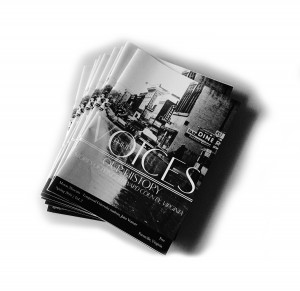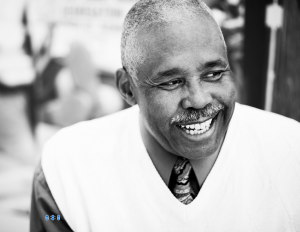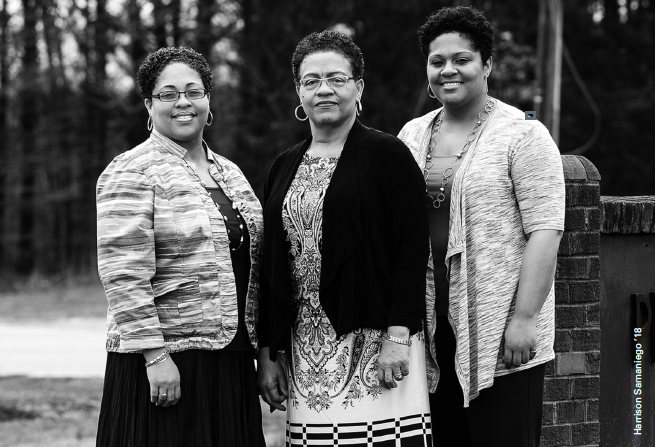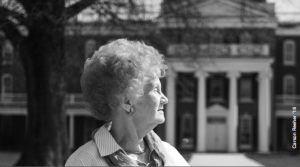Students document experiences of community members forever changed by school closings—and find themselves transformed as well
By DR. LARISSA FERGESON, DR. HEATHER LETTNER-RUST AND MICHAEL MERGEN

Edward ‘Blue’ Morton (left) and Armstead D. ‘Chuckie’ Reid (top page) are among the Prince Edward County natives whose stories are told in a student-produced magazine about how the closing of the county’s public schools from 1959-64 impacted their lives.
In the summer of 1959, Edward Blue” Morton could hardly wait to enter the fifth grade in Farmville, leaving behind his elementary school in the Hampden-Sydney district of Prince Edward County. But Morton never got the chance to board the big yellow bus that fall.
He was one of 3,300 children affected by the county Board of Supervisors’ decision to close public schools in defiance of court-ordered desegregation. Morton and his friends played ball, worked on the farm and “just played school” because there was no school to attend. He later spent a year with his sister in Pennsylvania and then returned to Prince Edward County in 1964, when the public schools reopened by order of the U.S. Supreme Court.
Morton’s experience during the school closings is one of 17 stories brought to life by Longwood  students in a 77-page glossy magazine titled Their Voices, Our History. Produced this spring and distributed free, it was the product of a General Education capstone writing course and an advanced photography course taught collaboratively by us—professors of rhetoric, photography and history. The project challenged students to move beyond the classroom and work alongside community members to tell their stories in a public, published way. Learning the civil rights history of Prince Edward is a powerful enough lesson in and of itself, but documenting that history—being responsible for representing someone else’s story—transformed how our students thought about themselves and their roles as students and citizens.
students in a 77-page glossy magazine titled Their Voices, Our History. Produced this spring and distributed free, it was the product of a General Education capstone writing course and an advanced photography course taught collaboratively by us—professors of rhetoric, photography and history. The project challenged students to move beyond the classroom and work alongside community members to tell their stories in a public, published way. Learning the civil rights history of Prince Edward is a powerful enough lesson in and of itself, but documenting that history—being responsible for representing someone else’s story—transformed how our students thought about themselves and their roles as students and citizens.
The Moton Museum, which formally affiliated with Longwood in 2015, is our vital partner in this collaboration between students and people the museum refers to as “storytellers,” who experienced Prince Edward’s civil rights history firsthand. The museum became an important learning and meeting space for our students and their storytellers, and it was the site of a public exhibit opening to launch the magazine at the end of April. Their Voices, Our History is a companion volume to our first student- produced magazine, 10 Stories, 50 Years Later, which was published in 2014. Both publications support the museum’s ongoing effort to encourage local citizens to share their experiences and to stimulate conversations about the past and its legacy.
To begin the process of creating this year’s magazine, students were paired first with one another in teams of two—a photographer and a writer. Only one of our 27 students was a rhetoric and professional writing minor, but we encouraged all students to think of themselves as writers for a public audience. Then we partnered the writer-photographer teams with community members who had volunteered to share their experiences.
We matched Rachel Love ’17, a sociology major from Danville, with Edward Morton, who told the little-known story of how, as a high-school junior at Moton High School in 1969, he organized a two-day demonstration against the Board of Supervisors to protest underfunded school facilities and the firing of a beloved white teacher. Rachel reported that Morton also helped to publish and distribute a newsletter, The Voice, during his time in high school. This newsletter supplemented what The Farmville Herald would not write. The Voice ran for two years, with a circulation of 500.

Art professor Michael Mergen, who coordinated photography for Their Voices, Our History, conducts a critique session with student contributors.

Everett Berryman Jr. has taken several Longwood classes to better understand U.S. and world history—Photo credit: Briana Adhikusuma ’16
For Rachel, learning about history from someone who was there not only informed her about a period that “until this year I never knew about” but also allowed her to see the power of her pen. “My writing abilities have never been great. I am more of a math/science person than I am history/ writing, but now I can see that I am a writer, a writer of history.”
One of Morton’s collaborators was his friend Armstead “Chuckie” Reid, now Farmville’s vice mayor, who has served on Town Council for 30 years. Reid helped organize the 1969 strike and also worked to publish The Voice. Only 8 years old when the schools closed, Reid was strongly influenced by the Rev. L. Francis Griffin, minister of Farmville’s First Baptist Church and local civil rights leader.
In summer 1963, as students took to downtown streets to protest the school closings and segregation, Reid painted protest signs and listened to Rev. Griffin instruct citizens in methods of civil disobedience. Griffin influenced Reid’s own organizing of the 1969 strike, as well as his later entry into local politics.
As Reid’s student writer, Will Barton ’17, a business major from Vinton, reflected, “Chuckie’s story is one of absolute triumph over a seemingly dismal situation … My personal favorite part of the project was learning about Chuckie’s work on Town Council because he worked alongside the relatives of those who had voted to keep him and his classmates out of school.” Will also observed, “This project has allowed me to learn that sometimes the best communication skills are just to listen to what others have to say.”

Longtime Longwood faculty member Dr.Theresa Clark (center) instilled a love of education in her daughters Shelly Clark-Reed (left) and Megan Clark ’05
The stakes were high: to tell someone else’s story and get it right. Students practiced interviewing techniques and analyzed how images and words functioned together to tell a story. We urged them to communicate frequently with their storytellers, who, unlike us, were not obligated to answer their texts and emails. Students learned how to communicate across geographical, generational, gender, racial and technological divides.
Katharine Troth ’16, a biology major from South Riding, recalled, “I began my work in this senior English course with little expectation for myself and the class. Rarely do I participate in classes that have realworld application, and I did not believe that this class would be any different. It was not until we went out to interview our storytellers for the first time that I really began to wake up to the fact that the work we were going to be producing would be valuable and applicable to more than just myself and my classmates. Over the course of the semester, I began to take more chances in my thought and actions.”
Students also had to take chances in class, where they were required to critique one another’s work repeatedly. Photographers posted their work on the classroom walls for every student to comment on. Every writer submitted a draft weekly for feedback. We facilitated the group’s suggestions that writers revise their copy to more accurately represent the places, people and events, and the storytellers’ important memories of it all.
During one of the last “crit” sessions, Claire Rew ’17, a communication studies major from Accomac, asked the group: “Do these stories read like too much of a history article?” She was concerned we had missed the powerful emotional impact the first volume seemed to carry. We, as the teachers, remained silent. It was time for the students to answer.
Each student confronted Claire’s challenge with evidence of the emotional power of the stories. Claire was satisfied, and so were we.
When it came time to decide on a title for the magazine, we discussed several options, and settled on Our Voices, Our History. We thought the dual phrase fit the publication nicely, as it referenced the voices of the storytellers and the students, and a shared, expansive community history. However, Becky Jones ’17, a liberal studies major from Tappahannock, quickly spoke up to challenge that thinking: “It’s not our voice; it’s their story and their history.” Becky and those who agreed with her explained to the class that it would sound as if the class had co-opted the storytellers’ history. We all agreed instead to Their Voices, Our History.
We had hoped for but could not have guaranteed that students would debate ideas about authorship and the plural nature of public historical memories. But they were able to do so because of the relationships they had developed with their storytellers and the weeks spent working with their words and images.
In the magazine, students produced new narratives of the school closings period, narratives that put young people’s activism at the center and countered the prevailing perception of this generation of students as “crippled” or “lost.”
As Kelsey Daniel ’17, a graphic design major from Purcellville, explained: “The students from Prince Edward County schools were angry about their opportunity for an education being taken away, so they did something about it. Whether it was through protests, seeking opportunities elsewhere or other ways of finding an education, the people in this community did not idly sit by and wait for the injustice to blow over. They took it in their own hands to reach out and inform the country and the government of the oppression being placed upon them, rather than waiting for someone else to take care of it.”
Kelsey’s ideas about her own role as a citizen changed because of this experience. “I have noticed that it has become a civic duty of mine to speak out against injustices I encounter,” she said.

Nancy Drudge Fawcett ’58 did her student teaching at the whites only Farmville High School and later served on the Prince Edward County School Board.
This kind of transformative learning is at the heart of our work to prepare students to become citizen leaders who contribute to the common good of our society. Carson Reeher ’16, a photography major from Williamsburg, succinctly put it this way: “Education, leadership, true engagement—those things happen outside the physical classroom. They happen outside the comfort zone, and they happen when you actually take the time to listen.”

